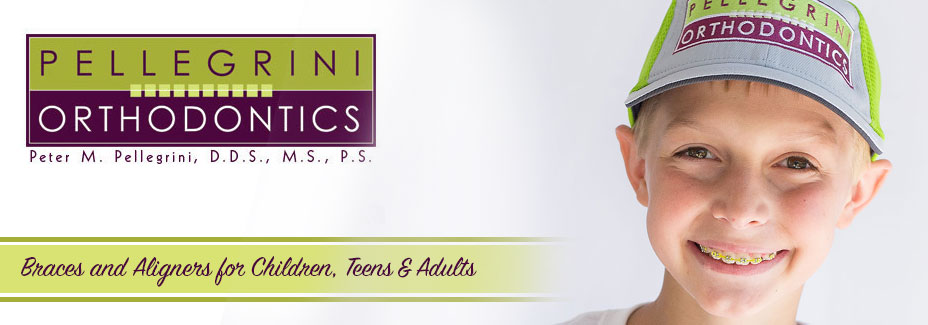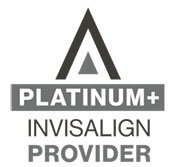Two Phase or Multi-Phase Orthodontic Treatment
 Phase I Treatment (Early Treatment):
Phase I Treatment (Early Treatment):
What is phase 1 or ‘interceptive’ orthodontic treatment?
Phase I (phase one) orthodontic treatment, also called ‘interceptive orthodontic treatment,’ refers to treatment that begins at an early age, and this ‘first phase of orthodontic treatment’ typically takes place when a young patient has both primary (‘baby’) teeth as well as some adult (‘permanent’) teeth present. If Dr. Pellegrini recommends a Phase I type of treatment, it is for good reason, as such a treatment plan will correct a dental developmental issue and/or prevent a current dental or jaw development problem from becoming more severe. It is not necessary that all young patients have phase I or ‘early’ treatment, but for certain children, it is of great benefit.
Typically, phase 1 orthodontic treatment is the first of two phases of treatment, and it occurs when a young patient is in need of intervention before starting regular orthodontic treatment, resulting in two separate treatment ‘phases’ or treatment plans. Orthodontic appliances, retainer-like devices, or partial braces may be placed to prevent a problem from occurring, correct a current problem or help to modify your child’s growth and dental development. There are a number of problems concerning tooth alignment, crowding and spacing, gum or periodontal health, jaws and facial development that can be corrected with Phase I treatment. It is common, but not always necessary, that a second phase of treatment will be needed after this first phase. Typically, the second phase of treatment is of shorter duration, reflecting the benefit of early intervention of the first phase of treatment.
When is phase I treatment started?
Phase I early treatment typically begins between the ages of 6-10 years, and it for this reason that any concerns be discussed with the orthodontist by no later than age 7 or 8. In fact, the American Association of Orthodontists (AAO) recommends that all children have an orthodontic evaluation by 7 years of age. Having an early consultation with Dr. Pellegrini is the best way to ensure that your child’s growth and dental development are optimal.
What are some indications for phase I treatment?
Some of the more common reasons or indications for Phase I treatment are dental cross-bites, skeletal cross-bites, underbites, excessively overlapping or deep bites, open bites (where the teeth in the front do not contact or overlap), jaw growth or jaws that are not in proportion to each other, severely protruding teeth, the presence of deleterious thumb, finger or tongue habits, clefts, or severe crowding or spacing of the teeth. Often early treatment turns severe problems that might require future jaw surgery into a more moderate problem that can be treated with braces or orthodontics alone at later date. See Orthodontic Treatment for Kids and Teens for more information and the benefits of early treatment.
In simple terms: Phase I is early orthodontic treatment that is sometimes recommended to help or prevent a bigger dental/orthodontic problems from occurring.
 Erin proves that wearing braces doesn't have to cramp your style. Phase II Treatment:
Erin proves that wearing braces doesn't have to cramp your style. Phase II Treatment:
What is phase II (two) orthodontic treatment?
Phase II treatment typically refers to the normal orthodontic treatment that may follow a first (early) phase I treatment. This usually involves placing braces on both the upper and lower teeth, once all the adult or ‘permanent’ teeth have come in or ‘erupted.’ Phase I usually does not correct alltooth and bite-related problems, therefore a second phase of braces (phase II) is needed to finish aligning the teeth and bite. When Phase I treatment has been successfully completed, however, this second orthodontic treatment phase (phase II) will be reduced significantly, reflecting the benefit of the phase I early correction. Dr. Pellegrini can straighten the permanent teeth and finish correctly aligning the patient’s jaws into the proper bite or ‘occlusion.’
In simple terms: Phase II orthodontic treatment is usually full upper and lower braces. It is the second part of two phases of orthodontic treatment, and that is where it derives its name.
Comprehensive Orthodontic Treatent (Full Treatment):
What is comprehensive or ‘full’ orthodontic treatment?
Full treatment (also called ‘comprehensive orthodontic treatment’) usually involves placing upper and lower braces on all the teeth. Sometimes other appliances or additional treatment aids may also be utilized depending on you or your child’s specific treatment plan and individual treatment needs. Full orthodontic treatment is usually begun when all or most of the adult teeth are present, making it possible for the orthodontist to fully correct the bite and align all the teeth.
In simple terms: Full orthodontic treatment usually consists of upper and lower braces, is most commonly started when all or most of the adult teeth are present.
Limited Orthodontic Treatment:
What is limited orthodontic treatment?
Limited orthodontic treatment is partial orthodontic treatment, either partial braces on some teeth or only the upper or lower teeth to address a 'limited' or localized issue. Just like the name implies, limited treatment only addresses a specific problem and is 'limited' to certain types of treatment.








